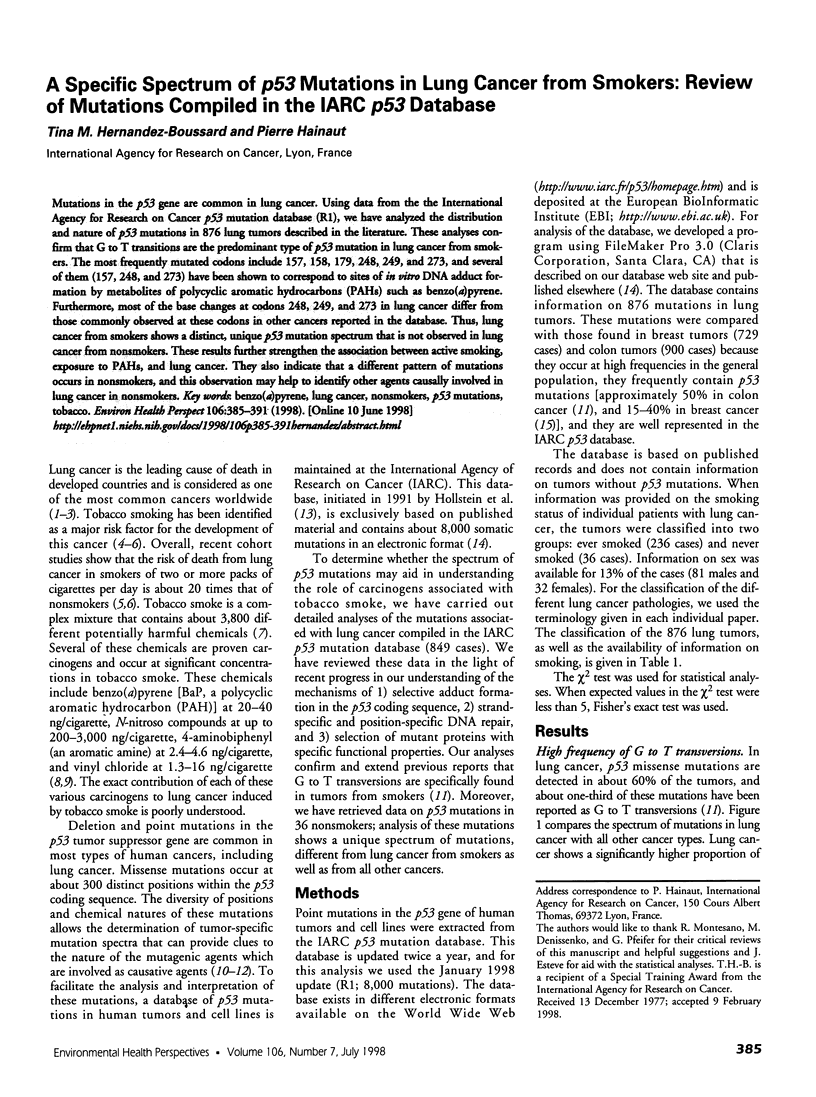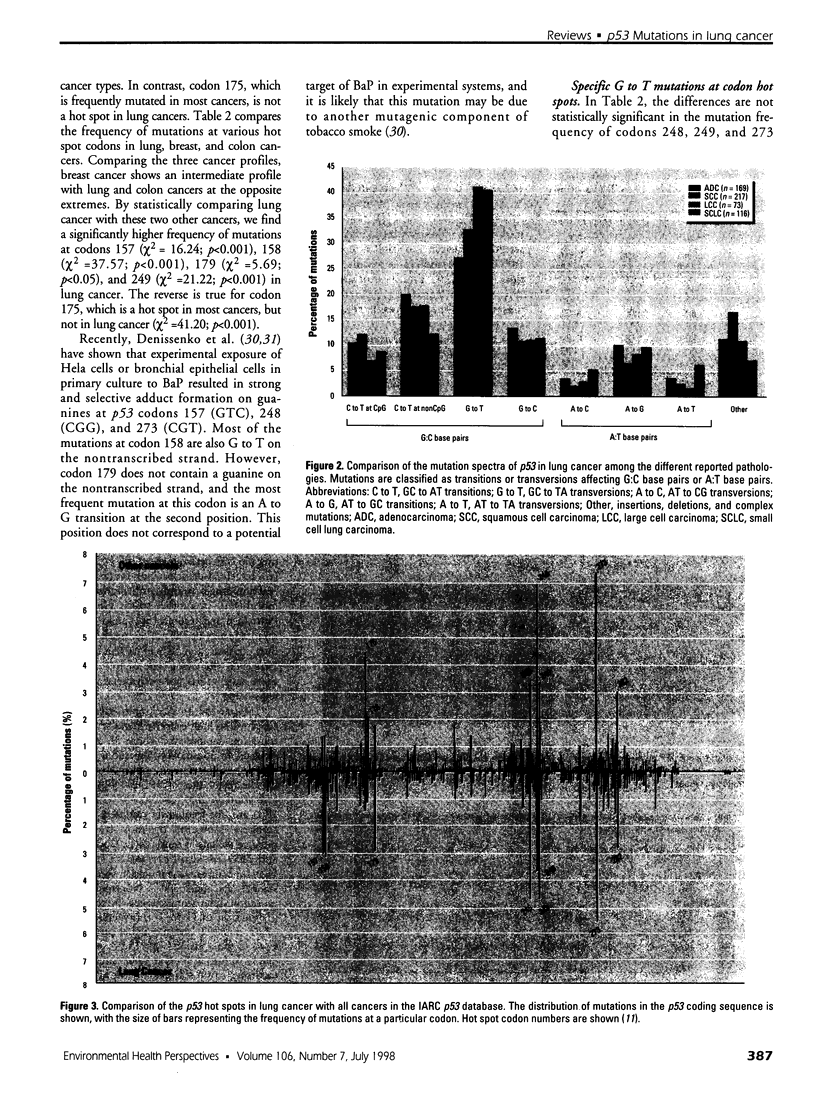Abstract
Mutations in the p53 gene are common in lung cancer. Using data from the the International Agency for Research on Cancer p53 mutation database (R1), we have analyzed the distribution and nature of p53 mutations in 876 lung tumors described in the literature. These analyses confirm that G to T transitions are the predominant type of p53 mutation in lung cancer from smokers. The most frequently mutated codons include 157, 158, 179, 248, 249, and 273, and several of them (157, 248, and 273) have been shown to correspond to sites of in vitro DNA adduct formation by metabolites of polycyclic aromatic hydrocarbons (PAHs) such as benzo(a)pyrene. Furthermore, most of the base changes at codons 248, 249, and 273 in lung cancer differ from those commonly observed at these codons in other cancers reported in the database. Thus, lung cancer from smokers shows a distinct, unique p53 mutation spectrum that is not observed in lung cancer from nonsmokers. These results further strengthen the association between active smoking, exposure to PAHs, and lung cancer. They also indicate that a different pattern of mutations occurs in nonsmokers, and this observation may help to identify other agents causally involved in lung cancer in nonsmokers.
Full text
PDF






Images in this article
Selected References
These references are in PubMed. This may not be the complete list of references from this article.
- Bartsch H., Castegnaro M., Camus A. M., Schouft A., Geneste O., Rojas M., Alexandrov K. Analysis of DNA adducts in smokers' lung and urothelium by 32P-postlabelling: metabolic phenotype dependence and comparisons with other exposure markers. IARC Sci Publ. 1993;(124):331–340. [PubMed] [Google Scholar]
- Bartsch H., Hietanen E. The role of individual susceptibility in cancer burden related to environmental exposure. Environ Health Perspect. 1996 May;104 (Suppl 3):569–577. doi: 10.1289/ehp.96104s3569. [DOI] [PMC free article] [PubMed] [Google Scholar]
- Bartsch H., Hollstein M., Mustonen R., Schmidt J., Spiethoff A., Wesch H., Wiethege T., Müller K. M. Screening for putative radon-specific p53 mutation hotspot in German uranium miners. Lancet. 1995 Jul 8;346(8967):121–121. doi: 10.1016/s0140-6736(95)92144-3. [DOI] [PubMed] [Google Scholar]
- Cherpillod P., Amstad P. A. Benzo[a]pyrene-induced mutagenesis of p53 hot-spot codons 248 and 249 in human hepatocytes. Mol Carcinog. 1995 May;13(1):15–20. doi: 10.1002/mc.2940130104. [DOI] [PubMed] [Google Scholar]
- DeMarini D. M., Shelton M. L., Levine J. G. Mutation spectrum of cigarette smoke condensate in Salmonella: comparison to mutations in smoking-associated tumors. Carcinogenesis. 1995 Oct;16(10):2535–2542. doi: 10.1093/carcin/16.10.2535. [DOI] [PubMed] [Google Scholar]
- Denissenko M. F., Chen J. X., Tang M. S., Pfeifer G. P. Cytosine methylation determines hot spots of DNA damage in the human P53 gene. Proc Natl Acad Sci U S A. 1997 Apr 15;94(8):3893–3898. doi: 10.1073/pnas.94.8.3893. [DOI] [PMC free article] [PubMed] [Google Scholar]
- Denissenko M. F., Pao A., Pfeifer G. P., Tang M. Slow repair of bulky DNA adducts along the nontranscribed strand of the human p53 gene may explain the strand bias of transversion mutations in cancers. Oncogene. 1998 Mar 12;16(10):1241–1247. doi: 10.1038/sj.onc.1201647. [DOI] [PubMed] [Google Scholar]
- Denissenko M. F., Pao A., Tang M., Pfeifer G. P. Preferential formation of benzo[a]pyrene adducts at lung cancer mutational hotspots in P53. Science. 1996 Oct 18;274(5286):430–432. doi: 10.1126/science.274.5286.430. [DOI] [PubMed] [Google Scholar]
- Dogliotti E. Mutational spectra: from model systems to cancer-related genes. Carcinogenesis. 1996 Oct;17(10):2113–2118. doi: 10.1093/carcin/17.10.2113. [DOI] [PubMed] [Google Scholar]
- Doll R., Peto R., Wheatley K., Gray R., Sutherland I. Mortality in relation to smoking: 40 years' observations on male British doctors. BMJ. 1994 Oct 8;309(6959):901–911. doi: 10.1136/bmj.309.6959.901. [DOI] [PMC free article] [PubMed] [Google Scholar]
- Essigmann J. M., Wood M. L. The relationship between the chemical structures and mutagenic specificities of the DNA lesions formed by chemical and physical mutagens. Toxicol Lett. 1993 Apr;67(1-3):29–39. doi: 10.1016/0378-4274(93)90044-x. [DOI] [PubMed] [Google Scholar]
- Gao H. G., Chen J. K., Stewart J., Song B., Rayappa C., Whong W. Z., Ong T. Distribution of p53 and K-ras mutations in human lung cancer tissues. Carcinogenesis. 1997 Mar;18(3):473–478. doi: 10.1093/carcin/18.3.473. [DOI] [PubMed] [Google Scholar]
- Greenblatt M. S., Bennett W. P., Hollstein M., Harris C. C. Mutations in the p53 tumor suppressor gene: clues to cancer etiology and molecular pathogenesis. Cancer Res. 1994 Sep 15;54(18):4855–4878. [PubMed] [Google Scholar]
- Guinee D. G., Jr, Travis W. D., Trivers G. E., De Benedetti V. M., Cawley H., Welsh J. A., Bennett W. P., Jett J., Colby T. V., Tazelaar H. Gender comparisons in human lung cancer: analysis of p53 mutations, anti-p53 serum antibodies and C-erbB-2 expression. Carcinogenesis. 1995 May;16(5):993–1002. doi: 10.1093/carcin/16.5.993. [DOI] [PubMed] [Google Scholar]
- Hackshaw A. K., Law M. R., Wald N. J. The accumulated evidence on lung cancer and environmental tobacco smoke. BMJ. 1997 Oct 18;315(7114):980–988. doi: 10.1136/bmj.315.7114.980. [DOI] [PMC free article] [PubMed] [Google Scholar]
- Hainaut P., Hernandez T., Robinson A., Rodriguez-Tome P., Flores T., Hollstein M., Harris C. C., Montesano R. IARC Database of p53 gene mutations in human tumors and cell lines: updated compilation, revised formats and new visualisation tools. Nucleic Acids Res. 1998 Jan 1;26(1):205–213. doi: 10.1093/nar/26.1.205. [DOI] [PMC free article] [PubMed] [Google Scholar]
- Hammond E. C. Smoking in relation to the death rates of one million men and women. Natl Cancer Inst Monogr. 1966 Jan;19:127–204. [PubMed] [Google Scholar]
- Hartmann A., Blaszyk H., Kovach J. S., Sommer S. S. The molecular epidemiology of p53 gene mutations in human breast cancer. Trends Genet. 1997 Jan;13(1):27–33. doi: 10.1016/s0168-9525(96)10043-3. [DOI] [PubMed] [Google Scholar]
- Harty L. C., Guinee D. G., Jr, Travis W. D., Bennett W. P., Jett J., Colby T. V., Tazelaar H., Trastek V., Pairolero P., Liotta L. A. p53 mutations and occupational exposures in a surgical series of lung cancers. Cancer Epidemiol Biomarkers Prev. 1996 Dec;5(12):997–1003. [PubMed] [Google Scholar]
- Hollstein M., Sidransky D., Vogelstein B., Harris C. C. p53 mutations in human cancers. Science. 1991 Jul 5;253(5015):49–53. doi: 10.1126/science.1905840. [DOI] [PubMed] [Google Scholar]
- Hollstein M., Sidransky D., Vogelstein B., Harris C. C. p53 mutations in human cancers. Science. 1991 Jul 5;253(5015):49–53. doi: 10.1126/science.1905840. [DOI] [PubMed] [Google Scholar]
- Husgafvel-Pursiainen K., Kannio A. Cigarette smoking and p53 mutations in lung cancer and bladder cancer. Environ Health Perspect. 1996 May;104 (Suppl 3):553–556. doi: 10.1289/ehp.96104s3553. [DOI] [PMC free article] [PubMed] [Google Scholar]
- Husgafvel-Pursiainen K., Ridanpä M., Anttila S., Vainio H. p53 and ras gene mutations in lung cancer: implications for smoking and occupational exposures. J Occup Environ Med. 1995 Jan;37(1):69–76. doi: 10.1097/00043764-199501000-00010. [DOI] [PubMed] [Google Scholar]
- Jones P. A., Buckley J. D., Henderson B. E., Ross R. K., Pike M. C. From gene to carcinogen: a rapidly evolving field in molecular epidemiology. Cancer Res. 1991 Jul 1;51(13):3617–3620. [PubMed] [Google Scholar]
- Kondo K., Tsuzuki H., Sasa M., Sumitomo M., Uyama T., Monden Y. A dose-response relationship between the frequency of p53 mutations and tobacco consumption in lung cancer patients. J Surg Oncol. 1996 Jan;61(1):20–26. doi: 10.1002/(SICI)1096-9098(199601)61:1<20::AID-JSO6>3.0.CO;2-U. [DOI] [PubMed] [Google Scholar]
- Kure E. H., Ryberg D., Hewer A., Phillips D. H., Skaug V., Baera R., Haugen A. p53 mutations in lung tumours: relationship to gender and lung DNA adduct levels. Carcinogenesis. 1996 Oct;17(10):2201–2205. doi: 10.1093/carcin/17.10.2201. [DOI] [PubMed] [Google Scholar]
- Lehman T. A., Greenblatt M., Bennett W. P., Harris C. C. Mutational spectrum of the p53 tumor suppressor gene: clues to cancer etiology and molecular pathogenesis. Drug Metab Rev. 1994;26(1-2):221–235. doi: 10.3109/03602539409029793. [DOI] [PubMed] [Google Scholar]
- Mazur M., Glickman B. W. Sequence specificity of mutations induced by benzo[a]pyrene-7,8-diol-9,10-epoxide at endogenous aprt gene in CHO cells. Somat Cell Mol Genet. 1988 Jul;14(4):393–400. doi: 10.1007/BF01534647. [DOI] [PubMed] [Google Scholar]
- McGregor W. G., Chen R. H., Lukash L., Maher V. M., McCormick J. J. Cell cycle-dependent strand bias for UV-induced mutations in the transcribed strand of excision repair-proficient human fibroblasts but not in repair-deficient cells. Mol Cell Biol. 1991 Apr;11(4):1927–1934. doi: 10.1128/mcb.11.4.1927. [DOI] [PMC free article] [PubMed] [Google Scholar]
- McLaughlin J. K., Hrubec Z., Blot W. J., Fraumeni J. F., Jr Smoking and cancer mortality among U.S. veterans: a 26-year follow-up. Int J Cancer. 1995 Jan 17;60(2):190–193. [PubMed] [Google Scholar]
- Montesano R., Hainaut P., Wild C. P. Hepatocellular carcinoma: from gene to public health. J Natl Cancer Inst. 1997 Dec 17;89(24):1844–1851. doi: 10.1093/jnci/89.24.1844. [DOI] [PubMed] [Google Scholar]
- Ory K., Legros Y., Auguin C., Soussi T. Analysis of the most representative tumour-derived p53 mutants reveals that changes in protein conformation are not correlated with loss of transactivation or inhibition of cell proliferation. EMBO J. 1994 Aug 1;13(15):3496–3504. doi: 10.1002/j.1460-2075.1994.tb06656.x. [DOI] [PMC free article] [PubMed] [Google Scholar]
- Palombo F., Kohfeldt E., Calcagnile A., Nehls P., Dogliotti E. N-methyl-N-nitrosourea-induced mutations in human cells. Effects of the transcriptional activity of the target gene. J Mol Biol. 1992 Feb 5;223(3):587–594. doi: 10.1016/0022-2836(92)90974-o. [DOI] [PubMed] [Google Scholar]
- Parkin D. M., Pisani P., Lopez A. D., Masuyer E. At least one in seven cases of cancer is caused by smoking. Global estimates for 1985. Int J Cancer. 1994 Nov 15;59(4):494–504. doi: 10.1002/ijc.2910590411. [DOI] [PubMed] [Google Scholar]
- Patel A. R., Obrams G. I. Adenocarcinoma of the lung. Cancer Epidemiol Biomarkers Prev. 1995 Mar;4(2):175–180. [PubMed] [Google Scholar]
- Pfeifer G. P., Holmquist G. P. Mutagenesis in the P53 gene. Biochim Biophys Acta. 1997 Aug 8;1333(1):M1–M8. doi: 10.1016/s0304-419x(97)00004-8. [DOI] [PubMed] [Google Scholar]
- Phillips D. H., Hewer A., Martin C. N., Garner R. C., King M. M. Correlation of DNA adduct levels in human lung with cigarette smoking. Nature. 1988 Dec 22;336(6201):790–792. doi: 10.1038/336790a0. [DOI] [PubMed] [Google Scholar]
- Phillips D. H., Schoket B., Hewer A., Bailey E., Kostic S., Vincze I. Influence of cigarette smoking on the levels of DNA adducts in human bronchial epithelium and white blood cells. Int J Cancer. 1990 Oct 15;46(4):569–575. doi: 10.1002/ijc.2910460403. [DOI] [PubMed] [Google Scholar]
- Puisieux A., Lim S., Groopman J., Ozturk M. Selective targeting of p53 gene mutational hotspots in human cancers by etiologically defined carcinogens. Cancer Res. 1991 Nov 15;51(22):6185–6189. [PubMed] [Google Scholar]
- Ronai Z. A., Gradia S., Peterson L. A., Hecht S. S. G to A transitions and G to T transversions in codon 12 of the Ki-ras oncogene isolated from mouse lung tumors induced by 4-(methylnitrosamino)-1-(3-pyridyl)-1-butanone (NNK) and related DNA methylating and pyridyloxobutylating agents. Carcinogenesis. 1993 Nov;14(11):2419–2422. doi: 10.1093/carcin/14.11.2419. [DOI] [PubMed] [Google Scholar]
- Ruggeri B., DiRado M., Zhang S. Y., Bauer B., Goodrow T., Klein-Szanto A. J. Benzo[a]pyrene-induced murine skin tumors exhibit frequent and characteristic G to T mutations in the p53 gene. Proc Natl Acad Sci U S A. 1993 Feb 1;90(3):1013–1017. doi: 10.1073/pnas.90.3.1013. [DOI] [PMC free article] [PubMed] [Google Scholar]
- Ryberg D., Hewer A., Phillips D. H., Haugen A. Different susceptibility to smoking-induced DNA damage among male and female lung cancer patients. Cancer Res. 1994 Nov 15;54(22):5801–5803. [PubMed] [Google Scholar]
- Takeshima Y., Seyama T., Bennett W. P., Akiyama M., Tokuoka S., Inai K., Mabuchi K., Land C. E., Harris C. C. p53 mutations in lung cancers from non-smoking atomic-bomb survivors. Lancet. 1993 Dec 18;342(8886-8887):1520–1521. doi: 10.1016/s0140-6736(05)80087-x. [DOI] [PubMed] [Google Scholar]
- Vineis P., Caporaso N. Tobacco and cancer: epidemiology and the laboratory. Environ Health Perspect. 1995 Feb;103(2):156–160. doi: 10.1289/ehp.95103156. [DOI] [PMC free article] [PubMed] [Google Scholar]
- Vähäkangas K. H., Samet J. M., Metcalf R. A., Welsh J. A., Bennett W. P., Lane D. P., Harris C. C. Mutations of p53 and ras genes in radon-associated lung cancer from uranium miners. Lancet. 1992 Mar 7;339(8793):576–580. doi: 10.1016/0140-6736(92)90866-2. [DOI] [PubMed] [Google Scholar]
- Wynder E. L., Hoffmann D. Smoking and lung cancer: scientific challenges and opportunities. Cancer Res. 1994 Oct 15;54(20):5284–5295. [PubMed] [Google Scholar]









